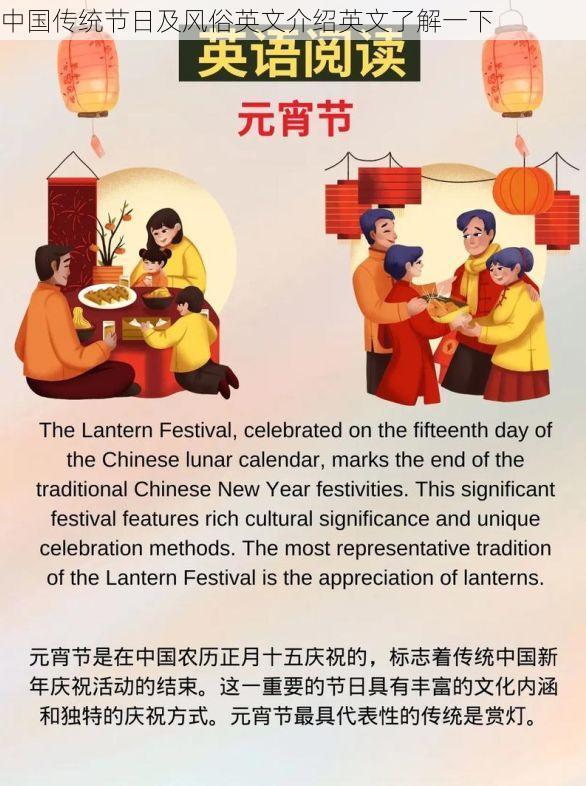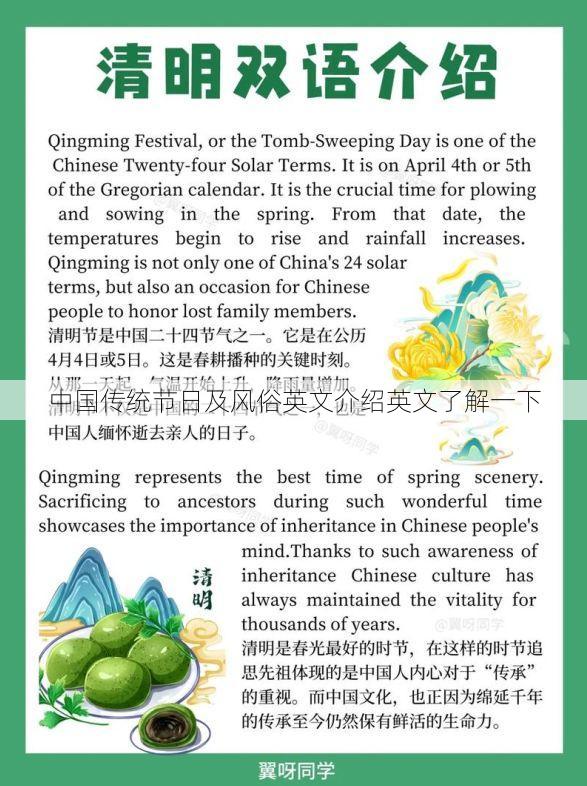中华文化熏陶下成长的人,我对中国传统节日有着深厚的感情。这些节日不仅是重要的文化符号,更承载着祖先智慧、民俗信仰和生活方式的传承。今天,我便想和大家分享一些中国传统节日的英文介绍,带领大家一起领略中华文化的独特魅力。
The Splendor of Chinese Traditional Festivals: A Glimpse into Cultural Heritage

Chinese traditional festivals are not mere dates on a calendar; they are vibrant expressions of a civilization's history, beliefs, and values. Each festival holds its own unique customs, rituals, and festivities that have been passed down through generations, adding a rich tapestry to the cultural fabric of China.
Let's embark on a journey through some of these time-honored celebrations:
1. Spring Festival (Chinese New Year): A Celebration of Renewal and Reunion
Spring Festival, also known as the Lunar New Year, is the most important holiday in China. It marks the beginning of a new year according to the lunisolar calendar, symbolizing a time for renewal, hope, and family reunion. The festivities typically last for 15 days, filled with traditional customs and celebrations.
Key Customs and Traditions:
New Year's Eve Dinner (Nian Ye Fan): Family members gather for a lavish feast, often featuring symbolic dishes such as dumplings and fish, signifying prosperity and abundance.
Red Envelopes (Hong Bao): Elders give red envelopes filled with money to children and unmarried adults, wishing them good luck and prosperity in the coming year.
Lion and Dragon Dances: These lively performances symbolize good fortune and ward off evil spirits.
Firecrackers: The loud bangs of firecrackers are believed to scare away bad luck and usher in a new beginning.

Lantern Festival: On the 15th day of the festival, people gather to admire beautifully crafted lanterns and enjoy sweet rice balls (tangyuan).
2. Lantern Festival (Yuanxiao Festival): A Festival of Light and Reunion
The Lantern Festival, celebrated on the 15th day of the first lunar month, marks the end of the Spring Festival festivities. It is a time for families and friends to gather under the glow of lanterns, symbolizing hope and unity.
Key Customs and Traditions:
Lantern Displays: Cities across China are adorned with colorful lanterns, creating a breathtaking spectacle of light.
Guessing Lantern Riddles: A traditional game involves riddles written on lanterns, challenging participants to solve them.
Eating Tangyuan: These sweet rice balls, symbolizing family unity, are enjoyed by people of all ages.
3. Qingming Festival (Tomb-Sweeping Day): A Time to Honor Ancestors
Qingming Festival, also known as Tomb-Sweeping Day, is a traditional day of remembrance and ancestor worship. It falls on April 4th or 5th each year, marking the beginning of spring. People visit ancestral graves to clean them, offer sacrifices, and pay respects to their departed loved ones.

Key Customs and Traditions:
Tomb Sweeping: Families visit graves to clean them, plant trees, and offer food and incense to honor their ancestors.
Kite Flying: Flying kites is a popular activity during this festival, symbolizing the release of sorrow and bringing good fortune.
Eating Cold Food: The festival name stems from the traditional practice of eating cold food as a way to commemorate the mourning period for Jie Zitui, a loyal minister in ancient China.
4. Dragon Boat Festival (Duanwu Festival): A Celebration of Strength and Loyalty
The Dragon Boat Festival, celebrated on the 5th day of the 5th lunar month, commemorates the life and death of Qu Yuan, a patriotic poet and minister during the Warring States period. The festival is renowned for its dragon boat races and the consumption of zongzi, glutinous rice dumplings wrapped in bamboo leaves.
Key Customs and Traditions:
Dragon Boat Races: Teams of rowers compete in dragon-shaped boats, a thrilling display of strength and teamwork.
Eating Zongzi: These pyramid-shaped rice dumplings, wrapped in bamboo leaves and filled with various fillings, are a traditional delicacy during the festival.
Wearing Fragrant Sachets: Children wear fragrant sachets (xiangbao) to ward off evil spirits and ensure good health.
5. Mid-Autumn Festival (Moon Festival): A Time for Family and Appreciation
The Mid-Autumn Festival, celebrated on the 15th day of the 8th lunar month, is a time for family reunions and moon-gazing. It is a harvest festival, signifying the end of the summer season and the start of autumn.
Key Customs and Traditions:
Mooncakes: These sweet pastries, filled with various ingredients such as lotus seed paste, red bean paste, or nuts, are an essential part of the celebration.
Moon-Gazing: Families gather outdoors to admire the full moon, sharing stories and enjoying the moon's beauty.
Lantern Displays: Lighted lanterns are often displayed in homes and public spaces, symbolizing unity and prosperity.
6. Double Ninth Festival (Chongyang Festival): A Festival of Longevity and Respect for the Elderly
The Double Ninth Festival, celebrated on the ninth day of the ninth lunar month, is a traditional festival dedicated to longevity and respect for the elderly. It is a time for families to gather and show their appreciation for older generations.
Key Customs and Traditions:
Climbing Mountains: The festival's name derives from the custom of climbing mountains, symbolizing a long and healthy life.
Eating Chrysanthemum Cakes: These cakes, made with chrysanthemum flowers, are believed to promote longevity and good health.
Drinking Chrysanthemum Wine: A traditional drink made with chrysanthemum flowers, it is believed to possess medicinal properties.
7. Laba Festival (Buddha's Birthday): A Time of Charity and Compassion
The Laba Festival, celebrated on the 8th day of the 12th lunar month, commemorates the birthday of Sakyamuni Buddha. It is a time for Buddhists to reflect on Buddha's teachings and practice compassion and charity.
Key Customs and Traditions:
Eating Laba Congee: A thick porridge made with various grains, nuts, and dried fruits, symbolizing abundance and good luck.
Offering Food and Incense to Buddha: Buddhists visit temples to pay their respects and offer offerings to Buddha.
Performing Charitable Acts: Many people practice acts of kindness and generosity during this festival, following Buddha's teachings of compassion.
Table of Chinese Traditional Festivals: A Comprehensive Summary
| Festival Name | Date | Key Customs & Traditions | Significance |
|---|---|---|---|
| Spring Festival (Chinese New Year) | 1st day of the 1st lunar month | New Year's Eve Dinner, Red Envelopes, Lion and Dragon Dances, Firecrackers, Lantern Festival | Renewal, Reunion, Prosperity |
| Lantern Festival | 15th day of the 1st lunar month | Lantern Displays, Guessing Lantern Riddles, Eating Tangyuan | Light, Unity, Reunion |
| Qingming Festival (Tomb-Sweeping Day) | April 4th or 5th | Tomb Sweeping, Kite Flying, Eating Cold Food | Remembrance, Ancestor Worship |
| Dragon Boat Festival (Duanwu Festival) | 5th day of the 5th lunar month | Dragon Boat Races, Eating Zongzi, Wearing Fragrant Sachets | Strength, Loyalty, Commemoration of Qu Yuan |
| Mid-Autumn Festival (Moon Festival) | 15th day of the 8th lunar month | Mooncakes, Moon-Gazing, Lantern Displays | Family Reunion, Appreciation of the Moon, Harvest |
| Double Ninth Festival (Chongyang Festival) | 9th day of the 9th lunar month | Climbing Mountains, Eating Chrysanthemum Cakes, Drinking Chrysanthemum Wine | Longevity, Respect for the Elderly |
| Laba Festival (Buddha's Birthday) | 8th day of the 12th lunar month | Eating Laba Congee, Offering Food and Incense to Buddha, Performing Charitable Acts | Compassion, Charity, Commemoration of Buddha's Birthday |
Beyond Festivities: Preserving the Essence of Tradition
Understanding the origins and significance of these festivals provides a deeper appreciation for the richness and complexity of Chinese culture. It is crucial to not only celebrate these traditions but also to actively participate in them, ensuring their preservation for future generations. From learning traditional crafts to embracing the values of family and community, we can contribute to the legacy of these vibrant cultural celebrations.
What are some of your favorite Chinese traditional festivals? Share your experiences and insights in the comments below. Let's keep the spirit of these ancient traditions alive.

























